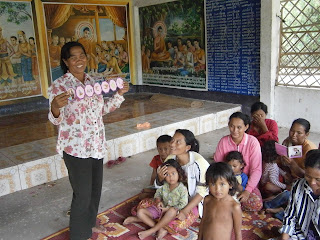I'll first tackle a question that might come up before reading the first word of this sentence. 'Birth spacing' (I may have mentioned this before) is phrased as such here due to still-lingering connections that the word 'control' has to the Khmer Rouge. And so, due to the dark memories that this word conjures (and the fact that the word 'control' tends to imply that there are no options), the word 'spacing' is used. Another good thing to know about some commonly shared misconceptions about birth spacing here is that after beginning any method (hormonal or non-hormonal), one cannot conceive again; this explains the introduction of the word 'spacing' (as the span of time between one baby and another need not be indefinite).
With that said, here's what I've been doing over the past two months with Population Services International (PSI) as part of my primary assignment for my third year with Peace Corps:
I am involved with the--beware: acronyms are abound--Communications and Marketing (C&M) department at PSI, more specifically, in the Reproductive Health (RH) sub-department, and even more specifically, the Community Mobilizer (CM) Project. The CM Project in the RH sub-department of the C&M department at PSI(/C for 'Cambodia', if you will) consists of six employees (all Cambodian) who hire and train 600 Community Mobilizers, local 'volunteers' for PSI that are paid $20/month, who set up information sessions in their commune (and surrounding ones) about birth spacing. The purpose of these sessions is to inform women of the importance of birth spacing (it would be important to note here that it is not uncommon for families in Cambodia to have up to ten members [that is mother, father, and eight children], so often, these families become progressively poorer with each child. and their children become progressively more malnourished). They explain the several methods they have to choose from and answer a myriad of questions typically relating to common misconceptions, rumors, and side-effects related to those methods.
A common misconceptions:
- When you put in an IUD, you can never bear children again, even if you take it out.
A common side-effect that is a large deterrent to usage:
- Weight gain with oral contraceptives
The hope is that at the end of a session, a woman will be interested in one of methods mentioned and be referred by the Community Mobilizer (CM) to a local government-run health center or a private health clinic in the PSI franchise (all run by Cambodians - PSI does not receive revenue enough for profit [at least, not of any considerable amount]).
Okay, so now that you have a little background of what the program I'm involved with does, what do I actually do? I go out on "Coaching/Field Visits" with PSI employees to any of the 15 provinces they work in where we do three things: 1) We meet with several groups of women in the communities where the CM lives/works to determine their knowledge of birth spacing and if that CM is active or not; 2) The CM holds an information session on birth spacing where we observe their presentation skills and knowledge on the topic and then; 3) give them feedback. Usually the PSI employee will continue the birth spacing session where the CM has left off; it is often not far into the session. I will typically assist my PSI counterpart (I work with six, but each goes out at separate times and to different regions) in explaining the information left unsaid. What is sometimes helpful is that a woman will ask if different birth spacing methods are used in the United States (or wherever they think I'm from [usually Australia or France]), and to their delight, they discover that they are, in fact, the same methods. This is all 'out in the field' (as they say). When I'm in the office (about 40% of the time), I typically help write up reports and look at plethora of data to then, hopefully, devise new plans to help increase the efficiency of the CM Project.
Okay, enough information. Here are some photos:
Okay, that's all for now. I'll be posting in a couple of weeks about my upcoming vacation back to Vietnam!
Talk to you soon,
Garrett
Saturday, September 1, 2012
Subscribe to:
Post Comments (Atom)







No comments:
Post a Comment